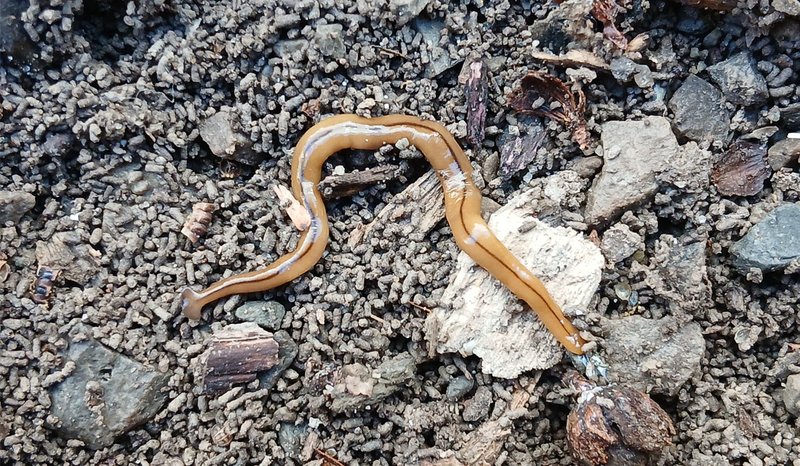
So, why does it matter if you can tell a hammerhead worm apart from a millipede or a slug? Understanding these differences can help you appreciate the biodiversity in your backyard and even inform your gardening practices. Plus, knowing what critters are hanging around can save you from potential pest problems. Let’s dive in and take a closer look at these fascinating creatures!
What Are Hammerhead Worms?
Hammerhead worms are pretty unique, and not just because of their unusual name. These creatures belong to the **flatworm** family and are known for their distinctive hammer-shaped heads. Their bodies are long, flat, and can be brightly colored, varying from pink to brown or even green. They typically range from 2 to 10 inches long, making them relatively easy to spot, especially when they’re crawling around in damp places.
You might be wondering where you’d find these critters. Hammerhead worms prefer humid environments, often residing in leaf litter, soil, or even under rocks. They’re native to tropical regions but have made their way to other parts of the world, including the United States. If you happen to stumble upon one in your yard, it’s important to know they can also be *predators*! They feed on earthworms and can be quite harmful to the ecosystem if their population gets too large.
So, what should you remember about hammerhead worms? Look for the flat, elongated body with a distinctive “hammer” shape at the end. They wiggle when they move, and they’re often seen slithering around after rainfall or during humid conditions.
Identifying Millipedes
Millipedes might not have the most glamorous reputation, but these little guys play an essential role in breaking down organic matter in the soil. Unlike hammerhead worms, millipedes are not worms at all; they’re arthropods, which means they have a hard outer shell and segmented bodies. They can be identified by their many legs—typically, they have two pairs of legs per body segment, which can total anywhere from 36 to 400 legs!
Next time you spot a millipede, take a closer look at its body. It is usually cylindrical and can be brown, black, or even brightly colored. When disturbed, millipedes tend to curl into a spiral, which is their defense mechanism. They’re not harmful to humans, but some species can secrete a defensive liquid that may irritate the skin.
Another interesting fact: millipedes are primarily herbivores. They feast on decaying leaves and organic matter, which is crucial for nutrient recycling in ecosystems. So, if you spot one munching away in your garden, think of it as nature’s little gardener!
Getting to Know Slugs
Slugs are perhaps one of the most recognizable garden pests. They are soft-bodied mollusks, closely related to snails but without that hard shell. Slugs have a unique, slimy texture and can also range in color from shades of gray to brown. Their bodies are generally oval-shaped, and they can be quite small—sometimes as little as an inch long, while others can stretch up to four inches!
You can often find slugs in dark, damp places like under pots, in mulch, or hiding beneath leaves. They’re primarily nocturnal, meaning they’re most active at night when the temperatures are cooler and moisture levels are higher. Like millipedes, slugs mainly feed on decaying plant matter, but they also have a reputation for munching on your garden plants and vegetables, making them a common nuisance for gardeners.
One key thing to note about slugs is their **mucus**. This slime helps them move easily across surfaces and keeps their bodies moist. If you see a slimy trail on the ground, chances are it’s from a slug. Just remember, while they might seem icky to some, slugs are a vital part of the ecosystem, helping break down organic material.
Comparing Hammerhead Worms, Millipedes, and Slugs
Let’s break down the main differences between these three creatures visually. This comparison can help you spot them more easily in your yard, so here’s a quick rundown:
| Feature | Hammerhead Worms | Millipedes | Slugs |
|---|---|---|---|
| Body Type | Flat and elongated | Cylindrical and segmented | Soft-bodied and oval |
| Color | Bright colors (pink, green) | Brown or black, sometimes colorful | Gray to brown |
| Movement | Slithering | Curling and walking | Sliding on slime |
| Diet | Predatory (mainly earthworms) | Herbivorous (decaying matter) | Herbivorous (plants and decaying matter) |
This table should give you a clear picture of how to identify each creature. Understanding these differences can help you address any gardening concerns you might have. For instance, if you’re dealing with plant damage, knowing whether it’s caused by slugs or another pest can help you find the right solution.
The Importance of Knowing Your Backyard Allies and Enemies
So, what’s the big deal about knowing whether you’re looking at a hammerhead worm, millipede, or slug? Well, for one, these creatures contribute differently to your garden ecosystem. Hammerhead worms, as mentioned earlier, can impact soil health by preying on earthworms. Millipedes assist in breaking down organic matter, while slugs can be both helpers and pests, depending on what they choose to munch on.
Being able to distinguish between these creatures means you can make better gardening choices. For instance, if you find that you have a lot of slugs, you might want to consider some natural deterrents, like diatomaceous earth or even inviting slug predators into your garden.
Also, learning about these creatures fosters a deeper connection with nature. Instead of seeing them as mere pests, you can appreciate their roles in the ecosystem. That newfound understanding can make your time in the garden even more enjoyable.
In conclusion, hammerhead worms, millipedes, and slugs might all be crawling around your garden, but they each bring something unique to the table—or garden! By knowing how to distinguish between them, you can make informed decisions that benefit your garden and the environment.
Next time you go outside, take a moment to observe these fascinating creatures. You might find yourself appreciating the diversity of life right in your backyard. So grab that cup of coffee, and let your curiosity lead the way—there’s a whole world of wonders waiting to be discovered!

